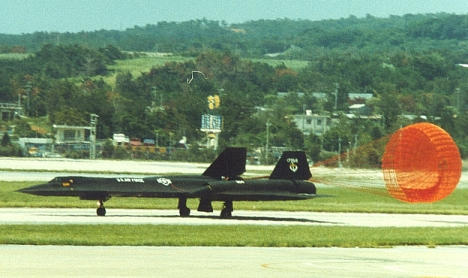
 1968
1968 
The SR-71's began arriving at Kadena (AKA "The Rock") in March of 1968. The operation to transfer the SR-71's from Beale to Kadena was know as "Glowing Heat". The first Detachment Commander was Colonel Charles Minter with Colonel Carl Estes as the Director of Maintenance. On 15 March 1968, OL-8 was declared Operational Ready for SR-71 sorties.USAF SR-71 Kadena Operations 
1968
Det 1 had Four Detachment names from 1968 to 1990
They are:
OL-8

OL-8 was established in March of 1968.
This followed SAC's designation for Reconnaissance Overseas Locations
RSO Dave Jensen designed the OL-8 patch
OL-RK
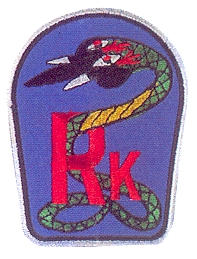
OL-8 became OL-RK on 30 October 1970.
OL-RK stands for "Operating Location - Ryukyus"... a chain of islands
in which Okinawa is situated.
OL-KA

OL-RK became OL-KA on 26 October 1971.
OL-KA stands for "Operating Location - Kadena".
Det 1
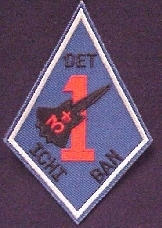 OL-KA
became Det 1 in August of 1974.
OL-KA
became Det 1 in August of 1974.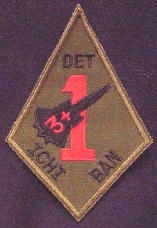
For 16 years it remained Det 1 until the SR-71 fleet was retired in 1990

Det 1 Retirement Patch
![]()
SR-71's First Combat Sorties Out of Okinawa
And so it went for 22 years:
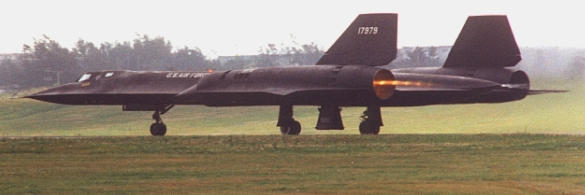
(Photo courtesy of Stephen Myatt)
SR-71's were rotated back to Beale AFB, California on a regular schedule. Commanders, Pilots, Maintenance and Lockheed Support personnel spent 30, 60 or 90 day TDY's to the Island and rotated back to Beale, well knowing another TDY to Kadena would be forthcoming in short order. The Blackbirds kept flying throughout the Vietnam War and the Cold War providing world wide critical reconnaissance assessments to Field Commander's and Presidents.
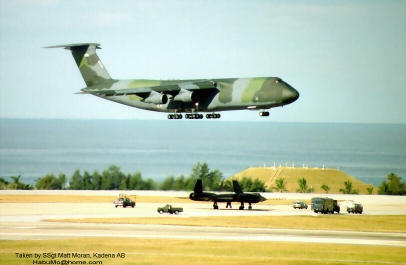
(Photo courtesy SSgt Matt Moran)
C-5 over Habu Hill
As the SR-71 operations folded at Kadena, Det One Commander, Lee Shelton had a plaque made up in Korea and placed for all to see on "Habu Hill". The inscription read:
This vantage point is dedicated to the magnificent SR-71 Blackbird, known worldwide as the Habu-an Okinawan Cobra of black sinister appearance, great stealth and lightning fast strike. The first SR-71 arrived at Kadena Air Base on 9 March 1968 and the last aircraft departed on 21 January 1990. Throughout those twenty-two years, the Habu roamed Pacific skies unchallenged in war and peace to insure the freedom of the United States and her allies. Habu Hill stands as a memorial to the SR-71, the special men and women who sustained its strategic reconnaissance mission and to all people who gather here and know that jet noise is truly the sound of freedom.
Sayonara Habu.
Detachment One, Ninth Strategic Reconnaissance Wing 1968-1990.
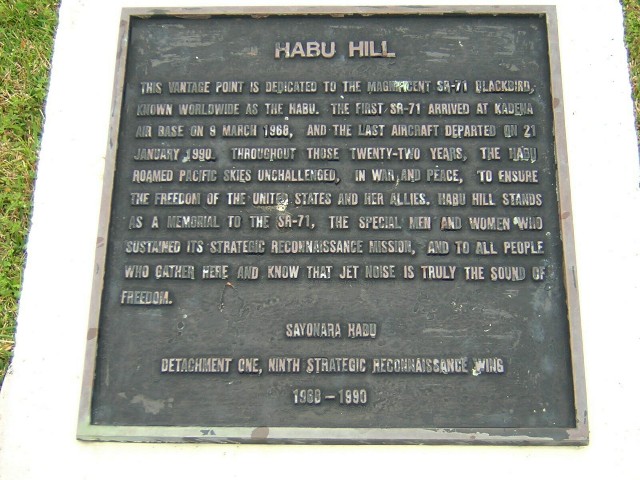
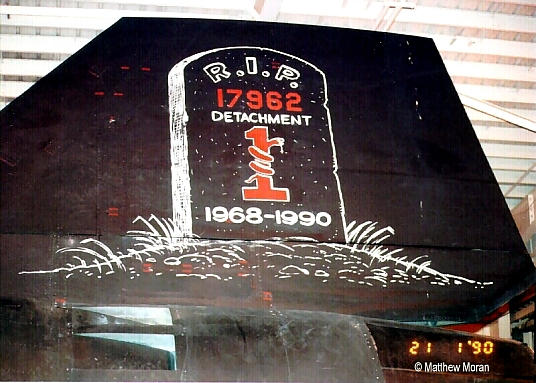
(Photo Courtesy SSgt Matt Moran; Artwork by Russ Maheras)
The Last SR-71 Flight from Det 1, Kadena AB, Okinawa:
This video was shot and narrated by Russ Maheras, ECM, 9th SRW. This is the actual 5AM launch on 21 January 1990 of SR-71 #962. Contains crew boarding, engine start, taxi and takeoff. This video is available by special order on DVD. Go to this URL to check it out or order: http://www.sr71.us/PayPal_Order.htm
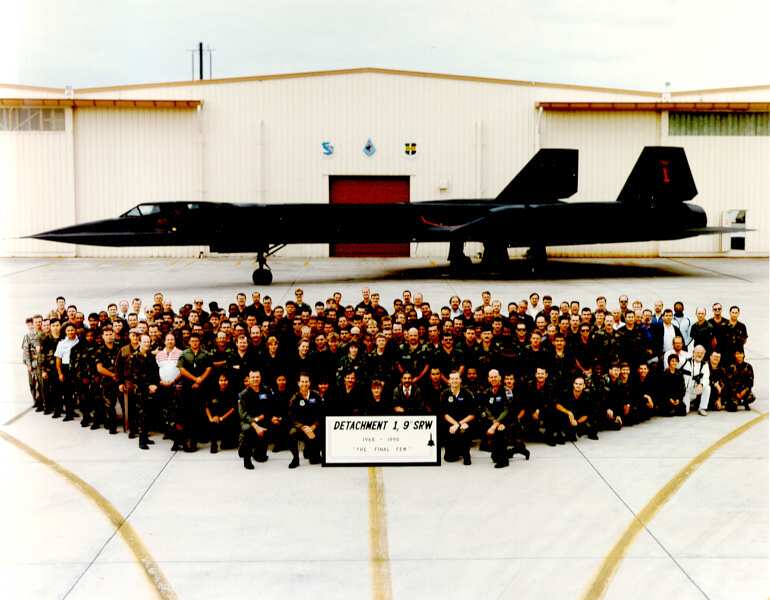
Final Few at Kadena-1990
(Photo by SSgt Matt Moran)
![]()
Notes of Interest about Det 1
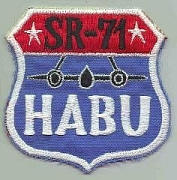
1. The Blackbird Kadena operations gave rise to the nickname "Habu". A Habu is the name of a Cobra snake (specifically a Pit Viper) in Okinawa. Because of the sleek "hooded" appearance of the Blackbird, the Okinawan's claimed it looked like a Habu snake. Thus the nickname. Additionally, SR-71 crews are called Habu's.
2. The SR-71's at Kadena was rotated back to Beale AFB, Ca for periodic maintenance and replaced with fresh aircraft approximately every 6 months. On two occasions the departing and the arriving aircrafts were plotted to pass each other at 80,000 feet, one headed for Beale and the other for Okinawa. One aircraft was 5,000 feet lower in altitude. According to the pilots involved, it was one incredible sight to see another Blackbird approach with a closure rate of the two aircraft at over Mach 6!
3. The "Rocket Ride" was an un-refueled mission to the Korean DMZ and return to Kadena AB. The flight lasted only 57 minutes. Habu crews attempted to break each other's record "Climb to Altitude" of 80,000 feet and Mach 3. Mission Recording Tapes verified their attempts. The fastest climb to altitude is held by Lt. Col. Jim Sullivan in 14 minutes.
4. Antics by both crew members and enlisted personnel were quite common at the facility. With the work hard, play hard management principle in effect at the OL, the imagination of most team members ran rampart. A sampling of some of the events that occurred follows:
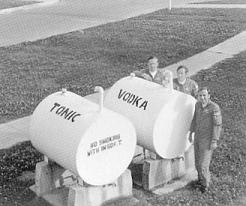
(Photo by Roger Jacks)
"Hooks Supply Tanks"
Shown is Roger Jacks, Richard Graham, Don Emmons
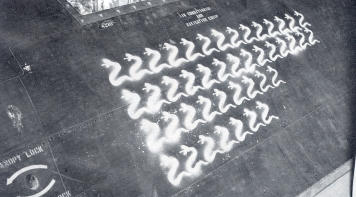
Each Habu snake represents an Operational Mission over Vietnam, Korea or other areas of interest.
(The original stencil artwork was done by Kirk Knutson, FMS)
6. Sortie Mission Objectives was not privy information to everyone in the organization. Those with a need to know, of course, knew that information. One sortie in SR #980 on 27 September 1971 and flown near Russian Soviet Naval exercises in the Sea of Japan near Vladivostok resulted in multiple radar returns and the first ELINT (Electronic Intelligence) signals emitted by the new SA-5 SAM missile. The ELINT "Take" had pulled in 290 different radars but by far the most important was the first elusive SA-5 signals. National Security officials were pleased with the Intelligence garnered from #980's Sortie. With Bob Spencer and "Butch" Sheffield as the crew; #980 developed an engine problem; the engine was shut down and then they diverted the aircraft low and slow into Taegu, South Korea.
The following "Habu" artwork is shown in small format for this web page.
Download the large image or the smaller one for your personal use. Thanks goes out to Ray
Zacher (Illustrator) and Bill Duffy for sending it to us.
Large Image-1500X1050, 253kb
Small Image-640X480, 67kb (Shown below)
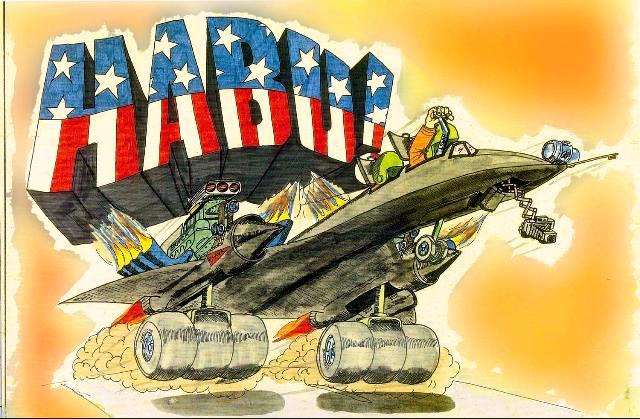
Here
is 20 thumbnail images of the SR-71 Tail Art including "Ichi Ban" and
the Playboy Bunny
http://www.sr71.us/tail001.html
Detachment 1 Commanders
- 08 August 1974 to 31 January 1975.............Colonel Thomas B. Estes
- 01 February 1976 to 30 June 1977...............Colonel Gabriel Kardong
- 01 July 1977 to 30 June 1979........................Lt. Col. Robert J. Cunningham
- 01 July 1979 to 25 August 1982....................Colonel Raphael S. Samay
- 26 August 1982 to 30 December 1984..........Colonel Randolph B. Hertzog
- 31 December 1984 to 04 September 1987....Colonel Thomas M. Alison
- 04 September 1987 to 1990...........................Colonel Lee M. Shelton, II
"Though I Fly Through the Valley of Death I Shall Fear No Evil - For I am at 80,000
Feet and Climbing" (sign over the entrance to the SR-71 operating location Det 1)
Editors Note: MSgt Ronald J. De Lozier, was Assistant Crew Chief on #974 at OL-8 and has provided readers of this page some insight into the activities at the Detachment during the early days of operation.
Wed, 21 Feb 2001 21:22 Ronald J. De Lozier, MSGT, USAF, (Ret) Writes: I noticed a lot of folks were in the program after I left in '72, so I figured I would give some recollections of what things were like in the early days at OL-8. One thing is we didn't have the "T" hanger when we first went there, it belonged to the spooky folks with "Brand X" (A-11) or (R-12), depending on who you or what you were told. We were given three hangers, not to far from the F-102 trim pad, which I had the pleasure of watching get torched and melted by a burner run on one of our birds. The second blackbird to use that pad totally destroyed the blast fence on its' burner run. The large pink "Q" hut looking hanger was the one we recovered the aircraft in after a mission, the two behind it were used for the primary and secondary aircraft. We could only taxi aircraft into the one hanger because the other two didn't have doors wide enough for the aircraft to taxi through if need be. The launch operation went normal for the most part, but we had to hook up a tow bar adapter to one of the main landing gear struts, attach a tow bar to the adapter and hook the tow bar to a G-75 towing vehicle, the driver wore a complete self-contained breathing apparatus under fire protection gear. We also disconnected the nose gear steering scissors and hooked up a nose gear steering bar. After engine start and pre-taxi checks were done, the aircraft was backed out of the hanger by the tug and steering was done by the Crew Chief. When the aircraft was in some semblance of pointing out to the taxi way, the tow bar and adapter were disconnected, NLG scissors were hooked back up, and the aircraft was ready for taxi. There was a knack to hooking up the steering, the crew chief relayed to the pilot were to turn the steering upper arm, while the guy on the steering bar tried to position the lower steering arm by turning the NLG tires, if the three didn't get it together, the guy on the steering bar would have the bar wrenched from his grasp and would do some fancy footwork to keep from getting whacked by the bar. We practiced these maneuvers many times at home base, including the backwards towing, but weren't told why until we had to do it at OL-8. The pink "Q" hut hanger was made out of concrete, and when the aircraft were recovered there, the aircrew had to taxi up a fairly steep ramp to get into the hanger, a little skill on the brakes and throttle were the key in getting up the ramp and into the hanger. During pre engine shutdown checks in the hanger, the concrete roof would pelt anyone who happened to be in the right place at the wrong time. One last note about the first group of folks that went to OL-8, it appeared that everyone had a penchant for building miniature Plexiglas pianos during the long mission flights, when not much was going on. It seemed whenever I went in to the shops or the staff offices, someone had a piano under construction. Regards, Ron De Lozier, CC 974.
Thu, 1 Mar 2001 19:35 Ron's Recollections (Continued):
There are two more OL-8 stories that come to mind, both having to do with the Security Police at Kadena. The first, I was with A1C Steve Reiser at a local watering hole, and we overheard this conversation between two SP's. "Hey, man, you know those blackbirds." "Yeah." "Well they go into outer space and orbit" "Man, that's BS" "No!!! Man, I've been standing guard over in that area, one taxied out and took off, three days ago and it just got back today. I've been checking out the tail numbers, and it's been gone all three days!!" "Really." "Yeah, and the same pilots were in the aircraft that were in it when it landed." Steve and I were trying really hard not to fall off the chairs from laughing so hard. Neither of us had the heart to tell these guys that the aircraft had a problem and went to another base for repairs. We Just let them believe some of the mystic that went with the territory.
Story #2. This actually happened at the T-Hanger on night shift. During a lull in the operations, there wasn't much to do after servicing the primary and secondary birds, some of us were turned loose, others had to stay until mid-shift came in. We were checking out some fun things, like putting drip pans on the three wheel carts, a chair in the drip pan and having pushing races, one guy would sit in the chair, tow bar for the front wheel steering in hand, and and another person would push, we had drag races? from hanger one to hanger four. Someone suggested putting a brake cooler on the drip pan and use it like a pusher prop swamp buggy. So we put some shot bags over the legs of the brake cooler to hold it down in the drip pan, and a chair in front of it. A length of .051 safety wire served as a throttle cable. So tiller (tow bar) in one hand, throttle in the other, and we lit off the brake cooler. It took a while to get up to speed, we ran out of room going to hanger 1 to hanger 4, so we tried going around the T hanger. No good, we couldn't turn the cart without it turning over and spilling driver, chair, brake cooler, shot bags and drip pan on the ramp. It made a lot of noise. We wondered what would happen (how fast could it go), if we didn't have to turn. As I was the senior member on the shift, I approached the SP's on duty with a maintenance problem: We just finished an overhaul of the engine on the brake cooler and we needed to check it out under load. You may have seen us trying to get it up to speed in the hanger, but there's just not enough room. Do you think we could get your roving SP and his truck to help us out? We need a flat run with an exact amount of weight on the cart for the brake cooler to push and reach 35 MPH. If it doesn't reach that speed, the engine will have to be replaced. The guard got on the radio and had the rover come and talk to us. I again explained the drill, we would be coming out of the center of the hanger on the cart with the engine at full throttle, go through the entry control point, down the taxi way, as fast as the propeller would allow. Could he accompany us, with his light flashing to clear the way. I would be in the pickup truck, monitoring the speedometer to insure we got up to speed. The rover was more than helpful, he told us he would have all light flashing and siren if needed. I told him the lights would be enough. We took the cart all the way down the leg of the T to supply, fired up the engine and taxied up the hallway at full throttle, past the maintenance shops, the stairs, through the engine/sheet metal shop and out the center doors. With lights flashing, the SP truck led us down the taxiway. We went the whole length of the taxiway to the end, almost. In our exuberance, we forgot about stopping the fool thing. The driver who shall be nameless, burnt off the soles of his boots dragging them to try and stop, he eventually got it slowed enough to turn the cart at the edge of the taxiway and was unceremoniously dumped off in the grass. We loaded the cart, chair, drip pan, shot bags and cooler in the back of the pickup and triumphantly convoyed back to the hanger with the SP rover and all its' lights flashing. Later in the tour, I heard of one of the maintenance controllers had gone down the stairs to the break room and heard this tremendous racket coming down the hallway, he peeked down the hallway, saw what was coming, turned around and went back up the stairs. Needless to say, we only did this one time, to my knowledge. And we attained 40MPH!!! The things that can happen while not on day shift!!
Fri, 13 Apr 2001 09:35 Ron's Recollections (Continued):
When #969 first came to OL-8/RK, in the winter of 1969, Major Tom Schmittou, RSO, on the ferry flight asked if I could put something
on the tail for him. Of course, I could, I was the swing shift Crew Chief and I could do anything I wanted, as long as the Crew Chief O.K.'d it. He asked
for a regular tabby cat with the words "TOM CAT'S KITTEN" under it. It took me about 3-4 days of playing with a 3' x 4' piece of stencil paper to get an
outline drawn. I ended up with a yellow tabby cat, black stripes and yellow eyes. I didn't think it was all that great, but everybody else seemed to like
it. It was still on the aircraft when I had to rotate back early because of a medical emergency
at home base. As was the rule, I couldn't take any pictures of my handiwork. So the picture is just in my memory
banks. I sure wish I had broken the rules in that area!!!
Ron De Lozier, MSgt (Ret)
Email: namba209@4dcomm.com
![]()
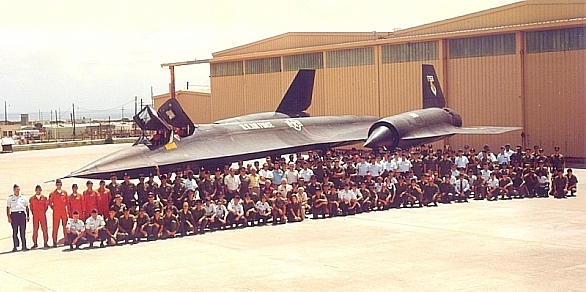
![]()
![]()
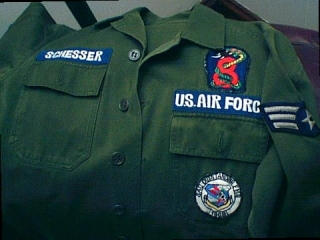
![]() Return
me to the Theaters of Operation Page
Return
me to the Theaters of Operation Page
| SR-71 Front Page | Links Page | Index Page | Recollections | 2001 Reunion |
| "SR-71 Blackbirds" Web Site Navigator | ||||
| First Created: April 15, 1996 - Last Revised: February 08, 2005 | ||||
| Copyright © 1996 Leland R. Haynes Email: sr71webmaster@sr71.us | ||||
"Hooks Supply Tanks" courtesy of Colonel Richard Graham and his
great SR Book "SR-71 Revealed" Go to this web site to order: http://www.habu.org/graham/
Original publish date December 31, 2000. Revised March 29, 2004
Page #46 of the "SR-71 Blackbirds"